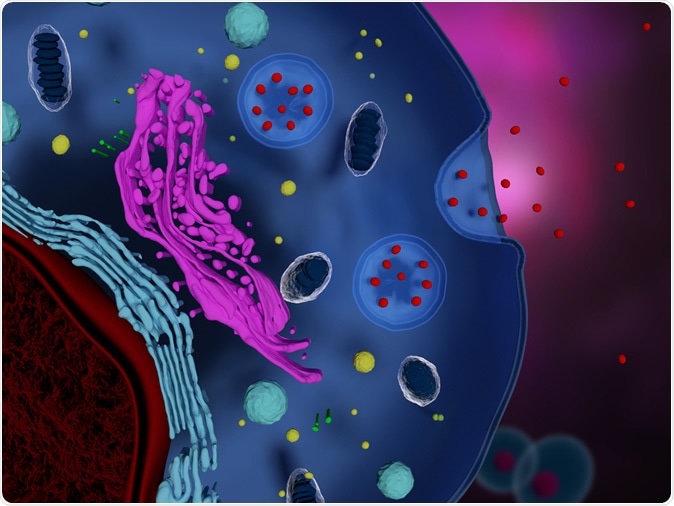During pregnancy, the mother and the baby communicate in a variety of ways. For instance, signals from the fetus are crucially involved in the initiation of labor and delivery.
One important means of such signaling is the passage of packages called exosomes, which are very small particles released from every cell. These are only about 30 to 150 nm in diameter, and travel in both directions between mother and fetus. Exosomes contain chemicals which act as signals between maternal and fetal tissues. Thus they serve as a biological indicator of the functional state of the tissue they arise from.

3d illustration of a cell secreting exosomes. Image Credit: Meletios Verras / Shutterstock
Earlier, the researchers found that exosomes from the fetal side tell the mother’s body that the baby has reached maturity. This triggers off labor and delivery. Now the researchers wanted to take this forward, finding out how far it extends and of what it is capable. Their aim was to investigate its usefulness in monitoring and possibly treating some fetal conditions like preterm labor. To do this they had to do two things: isolate and track the exosomes.
The current study looked at exosome passage and function, by staining them using two fluorescent dyes that attach to the cellular membranes. This would let them glow on confocal microscopy. One dye was the red fluorescent protein (RFP) tdTomato, while the other was the RFP-tdTomato/artificial green fluorescent protein (GFP) cyclic recombinase-reporter molecule that is found only in the tissues of the fetus. The mouse model used for the study shows a red color if the conditions are normal. However, if cyclic recombinase is present, the tdTomato is excised by the enzyme, leading to a green color. This helps detect the passage of cells and exosomes from the fetal side alone, since the GFP construct is not found in maternal tissue.
The mice with genes expressing the RFP tdTomato/GFP allele were produced by mating males mice that were homozygous for both of them (had two copies of each gene), with females who had neither. As a result, the fetal tissues (fetal membranes and placenta) and exosomes were positive for the RFP. The presence of fetal exosomes in the mother’s uterine tissue was tested by immunostaining with the CD81 molecule which targets exosomes via antibody binding, and RFP tdTomato expression was confirmed. An antibody to RFP tdTomato was added to the mother’s blood to bind the RFP tdTomato-positive fetal exosomes, causing them to precipitate. There were about 35% fetal exosomes in the mother’s plasma. Those that were positive for RFP tdTomato were isolated from maternal blood and uterine tissue.
Another set of exosomes to which the recombinase enzyme had been added was now injected into the peritoneal cavity of the mothers. This crossed the placenta and caused the removal of the RFP tdTomato from the construct in the fetal tissues which therefore became green. Fetal exosomes positive for GFP were also found in maternal blood.
This study shows that exosomes travel freely between the fetal and maternal side of the placenta, and carry cell signals that communicate both maternal and fetal physiological messages. On arrival, they regulate the functional activity of the target tissue on both sides. Maternal exosomes can lead to functional alterations in the fetal tissues. Fetal exosomes indicate the health and level of development of the fetus. Exosomes are trafficked freely as part of the paracrine system of communication during pregnancy, in fact.
The researchers think this could lead to their use as minimally invasive biological indicators of fetal health, for fetal monitoring via maternal blood samples. They can also be used as drug carriers, or transporters of other useful molecules, to the fetus. Their chief recommendation is that they can be used to advance research into the fetus without any invasive testing.
The next step will be to see if they can deliver drugs within exosomes to treat preterm births. Since these are likely to cross the placenta, they can reach the fetus and stop the occurrence of fetal inflammation. The importance of this is that fetal inflammation is a major cause of preterm labor. Preterm labor often ends in preterm birth, which affects 15 million pregnancies every year, and causes the death of 1 million babies. This could be prevented by arresting fetal inflammation.
Journal reference:
Cyclic-recombinase-reporter mouse model to determine exosome communication and function during pregnancy. Samantha Sheller-Millera, Kyungsun Choib, Chulhee Choib, & Ramkumar Menon. American Journal of Obstetrics and Gynecology. https://doi.org/10.1016/j.ajog.2019.06.010. https://www.ajog.org/article/S0002-9378(19)30774-4/fulltext